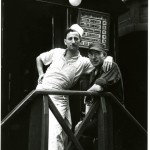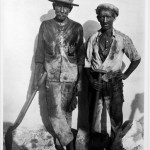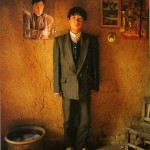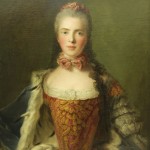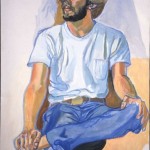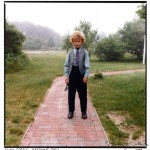Portraits
The Thousand Words Project (Ideas and Content), Lillian Barnett, 7th and 8th Grade Language Arts, Auburn Middle School
Integrating Literacy and Visual Art
Introduction-Setting of a story or a picture
A writer must use words to create the setting for a piece of writing. In some pieces of writing, the setting is critical to the story. In others, the setting is a neutral piece; it’s the story, not the setting, which is important. The story could take place almost anywhere.
A visual artist uses pictures to express thoughts, feelings, messages, etc. Sometimes the background of the picture is integral to the message of the painting, other times it is not necessary. The artist can choose how much of a background to include, or not to include any background and let the subject speak for itself.
Objectives:
1. To have students read a piece of writing or view a picture and try to determine the setting for the piece
2. To have students decide if the setting is critical to the piece
3. If the setting (or background in the picture) is determined to be important, students will be able to explain that importance
4. In a writing sample, students will be able to effectively write a piece that will include the setting as an integral section.
Maine Learning Results
B. LITERATURE AND CULTURE-Students will use reading, listening, and viewing strategies to experience, understand, and appreciate literature and culture.
C. LANGUAGES AND IMAGES-Students will demonstrate an understanding of how words and images communicate.
E. PROCESS OF WRITING AND SPEAKING-Students will demonstrate the ability to use the skills and strategies of the writing process.
F. STYLISTIC AND RHETORICAL ASPECTS OF WRITING AND SPEAKING-Students will use stylistic and rhetorical aspects of writing and speaking to explore ideas, to present lines of thought, to represent and reflect on human experience, and to communicate feelings, knowledge, and opinions.
Materials:
Laptops website (scroll down), Packet of pre-selected stories with which students are familiar, Writing materials, Presentation and discussion of the relevance of setting to a picture or to a story will take several days.
Procedure:
1. Students entering the classroom will see two images, picture 1 by Jean Marc Nattier, titled “Mm.Adelaine,” and picture 3, “Lunchroom Buddies, New York City,” by Walker Evans. They will be asked to write a brief description of their reactions to the pictures-what message, feelings, etc., is the artist trying to project.
2. Groups of 4 will be formed and students will share thoughts and writings.
3. Each group will share two thoughts about each picture with the entire group.
4. The teacher will lead a discussion about why students interpreted the picture as they did and what helped them to form their opinions.
5. This discussion should lead to the importance of setting when creating a picture. It should also include that sometimes setting is not important; there are other ways of getting a message across to the viewer, whether by clothing, posture, color, informality, etc.
6. Students again form their smaller groups and, using the packet of stories that has already been read and discussed by the class, choose 4 stories and discuss the importance of setting to each story.
7. Students will regroup into 4 different groups and share their findings with other students.
8. Students will return to their seats and create a journal entry on how setting can affect a reader’s interpretation of a story and a viewer’s reaction to an image.
9. Next students will view images 3, “Lunchroom Buddies,” and 4, “Dockworkers,” both by Walker Evans. Each of them has a setting, but the amount of detail in the pictures is different. A discussion will follow about differing amounts of detail that are necessary to create an impression of the picture.
10. Students will view the rest of the images, pictures 2, “Steven Schaffer,” 6, “Flinx Martin, Nantucket,” and 9, “Zhao Weidong, 16, Jiyuan country,” with the intention of sharing their impressions of what impact the setting has on their interpretation of the image.
11. Groups of four, different than previous groups, will be created to again analyze the effect of setting in stories in their packet. This time students will be looking for the amount of detail used to create the setting and how relevant the description is to the story.
12. The members of the group will share their findings with the rest of the class. As each image is discussed, it will be projected at the front of the room. Comments from other students are encouraged.
13. The class will be asked to create journal entries, describing and discussing the relevance of setting in relation to a named story from their packet. The students must choose a specific picture that closely matches the amount of setting in their story, explaining why the story and picture were paired.
14. There will be a class discussion about the significance of setting and its impact on a story and on the interpretation of an image.
Assessment
1. The teacher will make informal judgments as the different groups are working.
2. Journal entries will be read.
3. The teacher will read a short essay and have students write a response as to the amount of detail for the setting and the importance of that detail.
4. Students will create a written piece, using the element of setting as is necessary to getting their message across to the reader.
